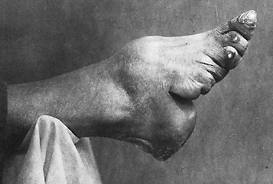Author's Note: Although informative, the following article may disturb those with weaker stomachs. I even began to get more and more disgusted as I learned more in depth what this tradition really was. Just warning.
Beauty. Think about what that word means to you today. What extremes have you or someone you know taken to meet the modern day standards of "beautiful"? Have you had a piercing, tattoo, worn Pointe shoes, or had plastic surgery? Do you realize with each of these acts, you are most likely hurting yourself no matter how big or small it may be. You probably had the choice to get that butterfly on your lower back tattooed or to buy those 6 inch glittery heels. Several Chinese women, however had no choice in getting their feet bounded.
Foot binding was an ancient tradition that dated back from the latest years of the T'ang Dynasty.(618-906 A.D.) Between the ages of 2-6, a mother would take her daughter's feet and massage them. After the relaxation, all of the child's toes except the largest would be broken and tucked under the foot. The foot would then be tightly wrapped in silk bandages for the rest of her life.
The reason for this painful procedure was because small feet were thought to be beautiful in this era. The average size of a bound foot was about 3 inches. Taking a ruler, that's not even half of my barely women's size 5 foot. Now, although the goal was to keep the feet from growing, it didn't work. Instead, the feet would grow up rather than horizontally.

The whole process took years to complete and once it had, it was even more tedious to care for. Women had to wash their feet daily to prevent infection and the feet began producing a foul smell. Those with bound feet were unable to walk properly and when working in fields would crawl. Because the feet would eventually become too smelly and gross, the bandages were always kept under ornate looking shoes. The only time they would be removed was in private.

This tradition lasted for more than 2,000 years before it was outlawed in 1912. Although it had continued for many years after in remote villages, many women were finally free of their bandages. Sadly, it had been too late and taking off the bandages caused more harm than good. You see, the bandages would cut off the circulation of blood causing numbness. Without them, the blood rushed back in and the painful bleeding began.
This is such an awful tragedy that will continue to go about, but in different forms. It's interesting to think what those in the future may think of our crazy fads now days, and what theirs may be.
"Beauty is pain. Pain is beauty."
-Cohenlm
Author's Note: Sources: hhttp://www.pattayadailynews.com/en/2010/09/16/the-painful-tradition-of-foot-binding-in-china
h/ttp://www.historyforkids.org/crafts/china/footbinding.htm